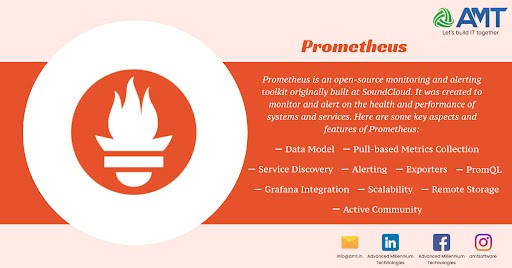Prometheus is an open-source monitoring and alerting toolkit originally built at SoundCloud. It was created to monitor and alert on the health and performance of systems and services. Here are some key aspects and features of Prometheus:
- Data Model: Prometheus uses a multi-dimensional data model with time series data identified by metric name and key/value pairs called labels. This enables flexible querying and aggregation of metrics.
- Pull-based Metrics Collection: Prometheus employs a pull-based model where it periodically scrapes metrics from configured targets, such as HTTP endpoints exposed by application services.
- PromQL: Prometheus Query Language (PromQL) is a powerful language used to query and aggregate metrics data. It allows users to perform complex queries, calculations, and aggregations over time series data.
- Service Discovery: Prometheus supports various service discovery mechanisms, allowing it to dynamically discover and monitor new targets as they come online or existing ones go offline.
- Alerting: Prometheus supports alerting based on defined thresholds and conditions. It can send alerts via various channels such as email, Slack, or custom integrations.
- Exporters: Prometheus exporters are agents that collect and expose metrics from third-party systems and services in a format that Prometheus can scrape. There are many official and community-supported exporters available for popular systems like databases, web servers, and more.
- Grafana Integration: Grafana, a popular visualization tool, can be used alongside Prometheus for creating rich dashboards and visualizations of monitoring data.
- Scalability: Prometheus is designed to be highly scalable and can handle large deployments with thousands of nodes and millions of time series.
- Remote Storage: While Prometheus has its own built-in time-series database, it also supports remote storage integrations, allowing you to offload older data to long-term storage solutions for retention and analysis.
- Active Community: Prometheus has a large and active community of users and contributors, which means there is extensive documentation, support, and a wide range of plugins and integrations available.
Prometheus has become a popular choice for monitoring modern, cloud-native applications and infrastructure due to its flexibility, scalability, and active development community.
Here are some additional details and aspects of Prometheus:
- Time Series Database: Prometheus includes its own time-series database optimized for high performance and efficient storage of metric data. It stores metrics in a compressed, efficient format that allows for fast querying and retrieval.
- Alertmanager: Prometheus is typically used in conjunction with Alertmanager, a separate component responsible for handling alerts generated by Prometheus. Alertmanager provides features such as deduplication, grouping, silencing, and routing of alerts to various receivers based on configured rules.
- Federation: Prometheus supports federation, allowing multiple Prometheus servers to scrape and aggregate metrics from each other. This is useful for hierarchical monitoring setups or for aggregating metrics from different teams or organizations.
- Autoscaling: Prometheus can be configured for automatic horizontal scaling by leveraging tools like Kubernetes Horizontal Pod Autoscaler (HPA). This ensures that Prometheus can handle varying workloads and resource demands effectively.
- Recording Rules: Prometheus allows users to define recording rules, which are precomputed queries that are periodically evaluated and stored as new time series. Recording rules can be used to reduce the overhead of complex queries or to create new aggregated metrics.
- High Availability: While Prometheus itself is not inherently highly available (it’s designed for a single-server setup), it can be made highly available using techniques like sharding, federation, or clustering with tools like Thanos or Cortex.
- Security: Prometheus does not provide built-in authentication or authorization mechanisms out of the box. However, it’s often deployed alongside other tools such as reverse proxies (like Nginx or HAProxy) or API gateways that handle authentication and access control.
- Prometheus Operator: The Prometheus Operator is a Kubernetes native toolkit that simplifies the deployment and management of Prometheus and related components in a Kubernetes environment. It provides custom resource definitions (CRDs) for defining Prometheus instances, service monitors, and alerting rules as Kubernetes resources.
- Client Libraries: Prometheus provides official client libraries in various programming languages (such as Go, Java, Python, and more) to help instrument applications and expose custom metrics for monitoring.
- Ecosystem: Prometheus has a rich ecosystem with many third-party tools and integrations available, including exporters for various technologies, libraries for integrating with other monitoring systems, and plugins for visualization tools like Grafana.
Overall, Prometheus offers a comprehensive monitoring solution with a wide range of features and capabilities suitable for monitoring modern, cloud-native architectures. Its flexibility, scalability, and active community make it a popular choice for monitoring infrastructure and applications in diverse environments.
Above is a brief about Prometheus. Watch this space more updates on the latest trends in Technology
